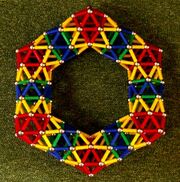To make a sphere is easy (any of the truncated icosahedra will do), but how to make a torus?
I used a small icosahedron as starting point, and bent it open at two pentagons having a common edge. This gives what we can call a decapod (see first picture on the left) with 10 legs in green, and let us call the single edge its nose (indicated in blue). These are the building blocks to build tori. The part counts are thus easy: for each decapod in the design, use 30 rods and 20-2=18 balls.

px

px

px

px

px

px
RIGHT: A torus with 3-fold symmetry
My first attempt was to connect these alternatingly, having the noses slightly up, then slightly down. This leads to exact closure with 6 decapods, and gives a basically hexagonal torus.
In the first picture on the right, the bodies of the decapods are red and yellow, and all the legs connecting the neighbors are green. Most balls have valence 6 ('flattish'), but on the outer rim there are 12 valence-5 balls ('curved'), and on the inner rim there are 12 valence-7 balls ('saddle-like').
These tori can be connected as regular hexagons, making a whole network possible. The principle is demonstrated well enough by connecting two, see second picture on the right:
The hexagonal nature of these kinds of tori is displayed more clearly by adding extra segments, as in the third picture on the right.
LEFT: A bigger torus with 5-fold symmetry
But if you connect the decapods alternatingly relative to a circular reference line, you get a torus consisting of 10 decapods, with a 10-gon internal ring, and a 20-gon outer ring, see second picture on the left where the inner and outer ring are denoted in blue. (Be warned: the coloring now does not correspond to the decapods, I did not have enough reds...)
However, these rings are not planar, as you may see from the third picture on the left:
--Leo Dorst 21:16, 23 May 2008 (UTC)